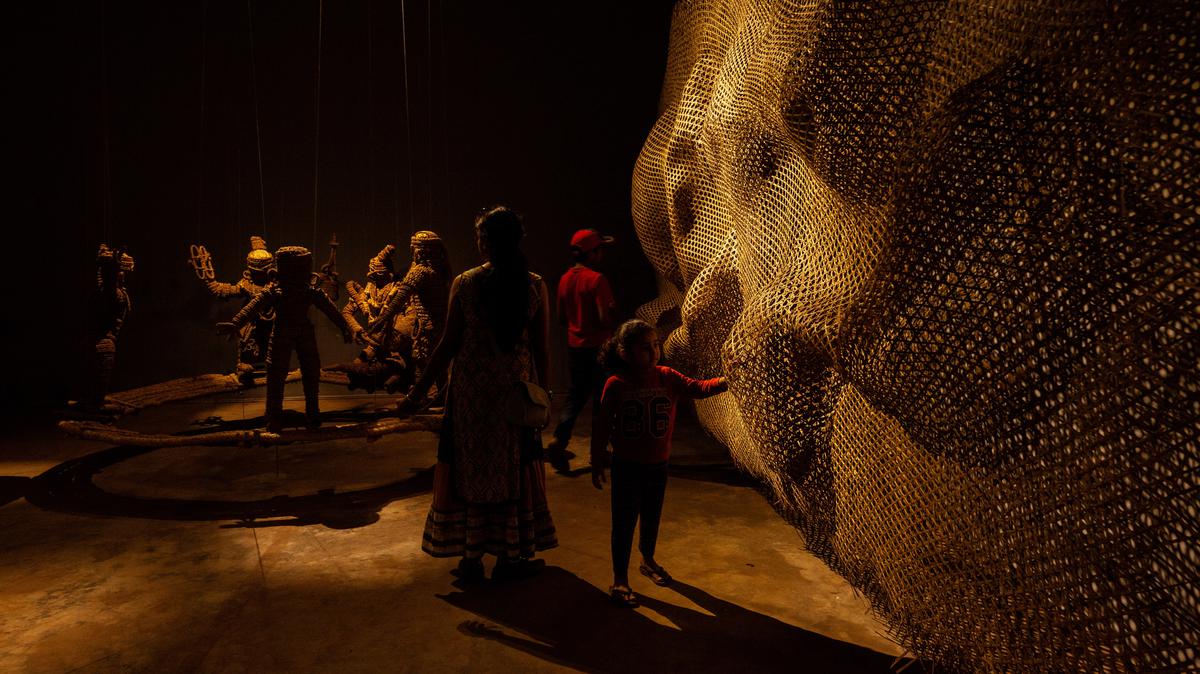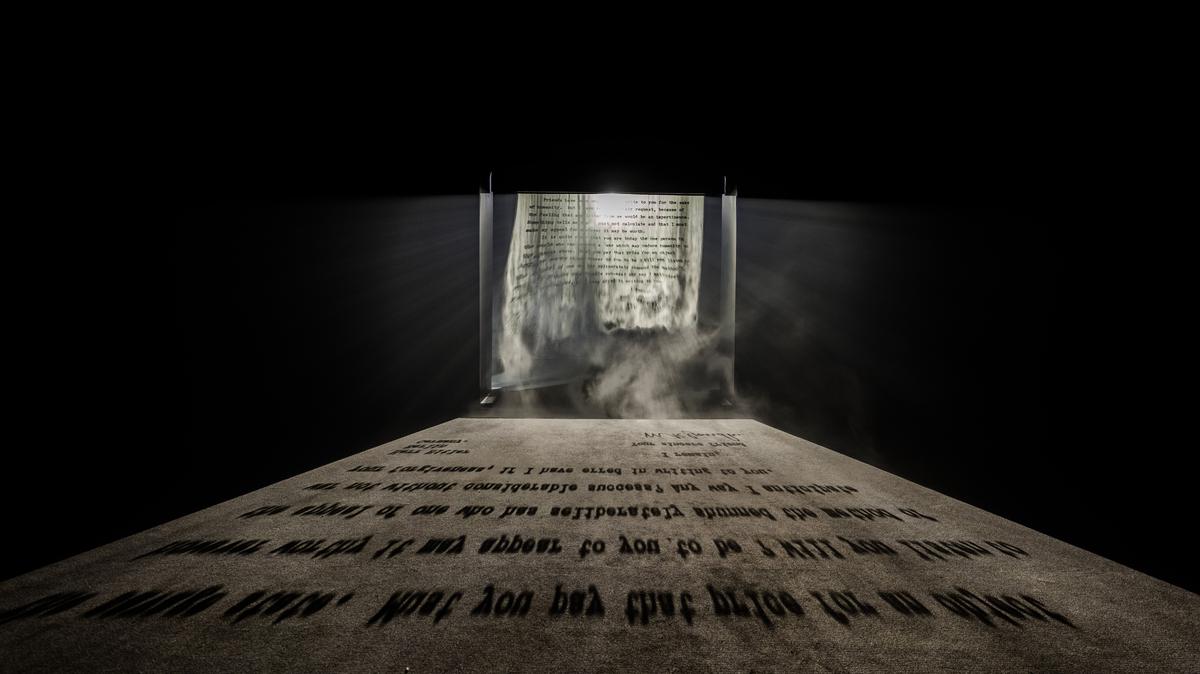Despite the delay in opening, over two lakh people have visited the Kochi-Muziris Biennale 2022-23 in the first month of the biannual contemporary art festival held at various venues in Fort Kochi and Mattancherry in Kochi. Curated by Singaporean artist Shubigi Rao, artworks by 90 artists from around world are featured this year in the exhibition titled ‘In our veins flow ink and fire.’
Also watch | Why Fort Kochi and Mattancherry became the venue of the Kochi-Muziris Biennale
This is the fifth edition of the biennale, which is being held after a gap of four years as the 2020 edition was cancelled due to the COVID-19 pandemic.
Apart from the exhibits by renowned names in the contemporary art world such as Zhanna Kadyrova, Jithish Kallat, and Massinissa Selmani, several other Indian as well as local artists from Kerala are also featured in the festival. Students Biennale, an extensive presentation of works by student artists from 22 art learning centres from across the country, is another major attraction.
The main exhibitions that opened doors on December 23, 2022, will be on till April 10, 2023.
Photo:
ASWIN VN
Aspinwall House, the 178-year-old warehouse-turned-gallery, which is the main venue of the Kochi-Muziris Biennale
Photo:
ASWIN VN
One of the highlights of Kochi-Muziris Biennale 2022-23, artist Vasudevan Akkitham’s ‘Almanac of a Lost Year (2020-21)’ is a collection of 365 small watercolour paintings to mark each day of the year that was lost to COVID-19, like a diary entry.
Photo:
ASWIN VN
A mud sculpture installation, part of ‘IDAM: Where Being Sprouts into Language’ exhibition, at Durbar Hall art gallery in Ernakulam

Photo:
KOCHI BIENNALE FOUNDATION
‘Bhumi’ by Gidree Bawlee Foundation of Arts is a community art project that by craftspeople from four villages in Bangladesh. Displayed at TKM Warehouse, it is a large-scale installation of puppets and mats made using jute and straw to represent the fluid nature of our existence.
Photo:
ASWIN VN
‘The Public Life of Women’ installation at Pepper House in Fort Kochi is a feminist memory project made up of photographs and stories of Nepalese women from all walks of life
Photo:
ASWIN VN
Pepper House, spicewarehouse-turned-gallery, is one of the venues of Kochi-Muziris Biennale. Apart from the art on display, the biennale is also an opportunity for visitors to explore the unique history and architectural heritage of Fort Kochi and Mattancherry.
Photo:
ASWIN VN
Vasudevan Akkitham’s ‘The Distance’ three-segment oil on canvas paintings narrate an almost autobiographical tale of a boy who migrates from village to a city.

Photo:
KOCHI BIENNALE FOUNDATION
Jithish Kallat’s ‘Covering Letter’ displayed at TKM Warehouse showcases Mahatma Gandhi’s famous letter to Hitler in the form a cascading fog
Photo:
ASWIN VN
‘Bombay Tilts Down,’ at Aspinwall House, is a multi-channel video installation by collaborative studio CAMP, consisting of tilt-down footage of Central Mumbai shot using a remotely-controlled CCTV camera.
Photo:
ASWIN VN
One of the many video installations at Aspinwall House, the main venue of the Kochi-Muziris Biennale
Photo:
ASWIN VN
Visitors experiencing ‘Such a Morning’, an installion made up of 62 handmade ramie, cotton and banana fiber papers including 17 digital video back projections. Edited by Delhi-based artist Amar Kanwar, it explores the question of what it means to see in the dark, and the power of silence and withdrawal during relentless crisis.
Photo:
ASWIN VN
‘Such a Morning’ installion made up of 62 handmade ramie, cotton and banana fiber papers
Photo:
ASWIN VN
A visitor checking out the photographic installation titled ‘Woh bhi line ka tha’ (He was one of us) in which artist Sandip Kuriakose assembles seemingly trivial objects found in cruising sites into layered forms conveying new meanings and associations.
Photo:
ASWIN VN
Kovviri Rajasekhar’s installation ‘The Other Side of The Geotube’, featured in the Students Biennale exhibition at VKL Warehouse, showcases the struggles of villagers in Uppada, a coastal hamlet in Andhra Pradesh that has been constantly ravaged by cyclones and sea. Rajasekhar has used washed-up and damaged materials collected from Uppada to create the installation, providing visitors a glimpse of the devastation that the people have suffered due to the climate change and the unscientific seawall project that failed to protect the village.
Photo:
ASWIN VN
In ‘The Other Side of The Geotube’ installation, artist Kovviri Rajasekhar has used torn jute sacks and sheets as canvas to write and illustrate the story of the Uppada village and the 1.4 km seawall constructed using geotubes in 2010, which was washed away by the sea and ravaged people’s lives.
Photo:
ASWIN VN
‘Art Room,’ in Cabral yard at Fort Kochi, where various art worshops are being held daily under the tutelage of trained artists
Photo:
ASWIN VN
Children participating in an art workshop at ‘Art Room’ in Cabral yard
Stay connected with us on social media platform for instant update click here to join our Twitter, & Facebook
We are now on Telegram. Click here to join our channel (@TechiUpdate) and stay updated with the latest Technology headlines.
For all the latest Entertainment News Click Here
For the latest news and updates, follow us on Google News.
